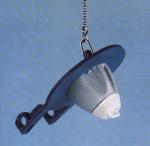Search engine visitors - click here to access entire "$ensible Home" web site
Click here to see a descriptive illustration of how several low-flush kits work.
Dear Jim: I always hear water running, but I want to keep our old toilets. I read new ones don't flush well. How can I fix the water leakage and are there any kits I can install to reduce the water usage per flush? - Don R.

A: Flushing toilets is the major water consumption activity in most homes which costs the typical family up to $200 per year. If you have leakage problems that allow the water to continually run, the annual water usage expense is even greater.
There are many types of do-it-yourself water-saving kits (prices start at only $5) that can save up to $100 per year on your water bills. Installing one often takes care of eliminating the water running problem too. You can install most in about five minutes.
The basic types of water-saving flush kits are: dual-flush handles, flapper valves, water dams, and diverters. The leakage problem you have is either a leaky ballcock valve or a leaky flapper. A water-saving flapper will solve the latter, but you will need a new ballcock to solve the former.
A dual-flush kit is one of the best methods to significantly reduce the water usage of any old toilet while still maintaining an effective flushing action. These kits (some have only five parts) provide a low-water usage flush for liquid wastes and a standard volume flush for solid wastes.
Some do-it-yourself kits use a single flush handle in place of the old handle. Push the handle down for a water-saving flush or left it for a full flush. Another design uses two separate handles. Push the longer handle down for a water-saving flush or the shorter handle for a full flush.
Inside the toilet tank, both designs work the same way. The water-saving flush only partially lifts the flapper, so it closes quickly allowing less water to flow out. The full flush lifts the flapper the standard amount.
There are many designs of water-saving flapper valve kits. They all allow the air trap inside of them to empty quickly so the flapper closes sooner than normal. To install one, just pull the old flapper up over the overflow tube and slip the new back down over the tube.
You can fine tune some of the flapper kits to get an effective flush with the least water usage. Some designs have a tiny adjustable hole at the bottom. By varying the hole size, the flush water volume can be controlled.
Water dams fit in the bottom of the toilet tank and spring out to seal against the sides. They effectively reduce the water volume in the tank without decreasing the water height or the flush pressure. Diverter kits divert some of the bowl water to the tank after each flush to save water.
Instant Download Update Bulletin No. 546 - buyer's guide of 8 toilet water-saving flush kits, flappers, dual-flush, diverters, water dams, installation instructions, annual savings of water/sewage chart by converting a toilet to a water saver, tips for conserving water in the bathroom, solutions to common toilet problems, descriptions and illustrations for several products.
Dear Jim: I am planning to buy some mini-blinds for privacy and to block heat loss through my windows. There is a huge price range from name brand styles to home center lines. What should I look for when comparing them? - Alice T.
A: Although the mini-blinds will not provide much insulation value to block heat loss through a window, they can create an effective dead air space near the window. They can also block unwanted glare during the summer.
The thickness and rigidity of the individual slats is a good indication of the quality of the mini-blinds. Also, compare the strength of the top section that mounts in the window opening. This is most important in wide windows.